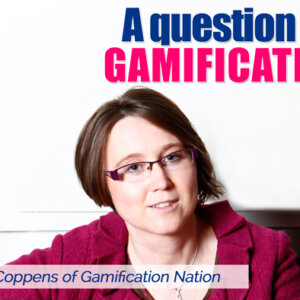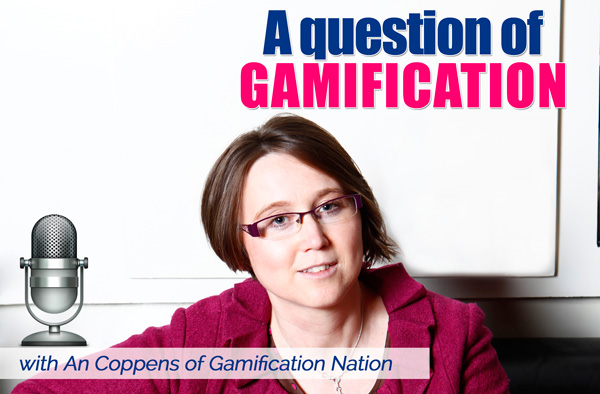[powerpress]
Podcast 10: How to create engagement in your community with gamification

We often receive questions on how to kickstart engagement in a membership or learning community, in this podcast episode we give you advice on how we would approach this for clients.
Show notes
Welcome to this week’s episode of a question of gamification. It’s brought to you by An Coppens Chief Game Changer of Gamification Nation. this week’s question of the week is: how can I gamify my membership or learning community so that our members get the most out of their membership and create a feeling of belonging?
The first thing you need to know as the owner of the membership, or the community, or as the curator or the admin, whichever name you give yourself, why did people join? Because why people join is a big clue as to why the gamification that you implement should happen.
What do they want to learn from you, whether you’re an authority and you have built a website around it, or you may have a specific course where you’ve invited people to be part of a community after or it’s a spontaneous group, basically, one that you’ve set up on Facebook or another platform to encourage people to stay in touch and to sort of upscale themselves all of the time.
Goal tracking is easier if you owned the race course. It is a concept I learned from one of my main mentors, James Schramko. He maintains that you need to own the racecourse. Meaning that you need to own your database, you own your customers, and you set them up in an environment that is yours. Because you never know when Facebook, LinkedIn, order social media or other platforms may turn off the service. Now, that doesn’t mean that you shouldn’t use existing platforms. But it should mean that you should always be aware that their rules, their ways of communication, are always changing.
My first recommendation is, make sure that your membership community is set up somewhere that you control on that you can influence so that you can also make sure people achieve success through your systems.
Then the next thing I would do is find out through a user survey, why do people join? And for your existing longer-term members why do people stay?
Other questions I would also ask are what games do they play? What tools do they use in business to track towards goals? And what devices like smart watches, phones etc. are they using to track for business or to track their fitness? That will give you an indication, first of all, whether they’re motivated to use trackers, whether they are motivated to use things that already include gamification. If they’re heavy users of social media, you know that they probably are already primed for gamification.
If you wonder whether your audience will like gamification, then check the above-listed items as guidance. If they play games, look for the type of game that gets mentioned most often as inspiration for game mechanics. We did work with a female organization, the kind of game that people played the most were puzzles and casual games, such as Candy Crushers, and other easy to play mobile games. There were a few exceptions of extreme gamers and, who loved role-playing games and massive multiplayer online games.
Depending on the audience you have in your group and in your target audience, you may have different game mechanics and the look and feel of how you implement gamification may be different.
The starting point should be user research with a user survey. Then look at why they joined, which could be the first goal that you make them set in the onboarding onto your particular membership program. You as the owner or authority expert or trainer, you guide them towards success in that specific area. That could be through personal messaging. But it could also be through a combination of personal messaging and game mechanics that track progress towards a goal.
We developed our own goal setting plugins to do that, which works on WordPress websites. And then we integrate that together with Gamipress, which is a gamification suite for WordPress, again. When adding gamification, the thing to do here is to make it valuable and to make it relevant to your audience. Whatever is not relevant, don’t enforce it as compulsory. I would say even in the age of many people opting out of being tracked, allowed them the option to opt out.
So that if somebody asked, look, I don’t want to be tracked, I don’t want to track against my goals, you can say, that’s okay. In that case, you also need to make sure that you have a journey for those that don’t like tracking but do want encouragement. That might be more the creative use of messaging, and checking in.
What gamification can add to a community is you can allow people to unlock new content based on performance in the membership or learning community. That can be based on the amount of things they report back, the scores they attain on either knowledge quizzes or activities that are relevant towards the goals they want to hit. The key word here is to make it relevant to them, make sure that you capture things that are important to them, not just to you as the owner.
Another cool thing that we often do, and have done on a few occasions for specific learning communities and membership communities, is to allow members to earn status.
A status like for example on LinkedIn, you have an all star status, if your profile is super filled in and you’re sharing, and you’re doing different things. But you could also make them more creative. So you could have the tourist, the rookie, the heavy user, the VIP, whichever titles fit the purpose of your community. People unbeknownst to themselves do actually pay attention to that. I mean, why else? Would it stay on LinkedIn? If it didn’t work? Right?These guys have analytics on most things.
How does the status appear? Well, it can be based on the number of posts, the number of answers, numbers of questions. But also, it could be based on goal achievement, it could be based on different things that you set to track within your community. If you’re doing this on other people’s platforms, check that this is possible and that you have control over it. I see a lot of membership platforms, communicate that they include gamification, but when you scratch below the surface it isn’t available.
We have also on some membership platforms tried to gamify with a mishmash of integrations, we can often make it work but it’s not nice looking. And it’s not a great user experience. So be mindful when you are deciding to to to go down the gamification route is to also be open as to what platforms you may want to use.
Status is one thing. The other game element that may make sense is to have leaderboards. I’m not a big fan, especially in the learning space to include leaderboards. Because it drives competitive behaviour. In effect, you are making people stand out negatively in a learning community when they are not in the top three. They may feel like they’re dumb, they don’t know enough or they’re not good enough, which is maybe reinforcing the reason why they started to learn. And they may get disheartened a lot quicker. Some people will feel motivated to do more, so it is not all bad.
The other question I had to ask in the user survey, is why do people stay in the community. And often what we find in a membership community, that people join for knowledge, they join because they know the owner, they join for a specific course. But they stay involved, if the engagement and the information they receive is useful and appropriate and relevant to them.
You want to make sure that there’s a regular flow of questions. You may want to have a number of power users, those power users identified themselves naturally by being the ones who from day one, start to ask questions. You may want to encourage that from day one, by saying in the onboarding onto your platform, start by introducing yourself and ask your burning question, do a bit of research and start to comment, so that for them to move from rookie to fully fledged member, you’ve already trained them into the kind of behaviour you want to see happen time and again. It should be part of your onboarding, to train them into sharing, commenting, etc.
With networks like, for example, Stack Overflow, which is an IT network, where it people ask questions around technical issues. They use the voting game mechanic where members vote up answers and also vote up questions. As result members act as curators, the better the questions and the better the answers, you both earn kudos or points on either end. Those with the best questions and the best answers will earn credibility over time in a specific field. For example that could be in Java scripting, that could be in html5, that could be Linux, it could be in a variety of sources. And in this particular community, people have earned enough kudos that it actually impacts their job prospects and employability.
Understand what would be the most relevant thing to your audience? Is it employability? Is it to be seen as a fellow expert? Is it to gain maybe online curator rights in your community.
I worked on a community for climate change, where we encouraged people to post and share, but only the regular contributors would rise to the top. They would eventually be asked to become a moderator for a specific trade or a specific topic because they displayed really deep knowledge, really deep understanding of the actual topic at large. Whether your pet topic was renewable energy or another area in climate research, the purpose of the community was for researchers to share it to both publish as well as read other people’s work to improve their knowledge.
What works also very well in membership communities are quests, quests with the shape of a 30-day challenge, or five-day challenge, to get people to boost themselves towards a goal that’s relevant to them, going back again, to that specific reason why they joined. Implementing a quest is up to you, encouraging is up to you. Don’t expect it to happen without you making a song and dance about it. No matter how good your technical setup and how many game elements you introduce, you still need the human to drive it.
If members see no interaction from you, as the main manager, the trainer, or regular feedback from the people that own the site, it will eventually become a bit like tumbleweeds, no noise, no nothing and everybody lurking in. Don’t forget that even on the great social media platforms that we see today. Only a percentage of users post regularly, the rest lurks and watches, but doesn’t necessarily engage all that much.
Make it easy, but also make it interesting for people to share, to look for feedback, to get input on what they need to do. Highly motivated people will show up no matter what, in most communities. As an owner, take care of them, look after them, and share the results based on activity.
Case studies where people can learn well actually, this person consistently hit their goals because they actually track their feedback, track their performance on a regular basis, will do better over time. What gets tracked gets done very often, even in the learning community.
Make sure that what you are tracking is a combination of quantitative and qualitative stuff. So that you don’t just have the number of questions asked, the number of posts, you also want an element of peer rating, peer review, and expert rating, expert review. If you’re the expert or leading an expert community you want to weed out behaviour like just posting for quantity sake, or just consuming for quantity sake, regular logins work for very many learning related applications. For example, language learning app Duolingo, for years have included a login streak where you basically keep the streak if you log in once a day, every day and you do a few exercises.
Other things that you could do are trophies based on actions taken badges, again earned for specifics for specific events, specific learning specific qualifications. As a general yardstick or rule, I would say always include an onboarding quest.
If people look into your community for employability, then allow for peer rating, make sure that it’s well curated. Then there should also be an element of showcasing publicly that actually, that person has proven over time to have good knowledge, whether that’s through points, whether that’s true status, whether that’s through certification. You decide on how you want to implement that.
We worked with a fitness community, where we gave contribution points where we gave points for sharing specific books, for giving advice on things that have worked for people. We also had a specific group that earned VIP rights so they unlocked new content, but they needed to have hit a certain number of points over the time period. The tracking for specific status improvements or specific content could be anything from five days to completing his challenge over a whole year long activity.
At the end of the day adding gamification to your community can be very creative. And when all is said and done, what works for engagement is you being present. Human Centered Design is about making humans talk to humans, not about game elements, talk to humans, or bots, for that matter. People are smart enough to discover who’s wat and what’s what’s over time. Make sure that you are part of your community, make it congruent with the messaging and with the type of goals people have for joining and for staying. And then have fun with it.
I hope you enjoyed today’s episode of A Question of gamification. And we look forward to hearing from you next week. And if you want your question answered, please send it to us. You can do so in the comments. Or you can just post a question to us on email fun@gamification nation.com. Thank you and talk to you next week.





